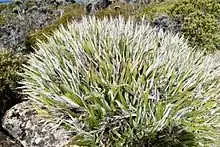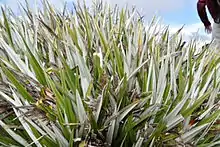Astelia alpina
Astelia alpina called pineapple grass, silver astelia, or perching lily is a commonly found species in alpine and subalpine areas of Tasmania and the Australian Alps.[1] It is a perennial herb that typically dominates its environment by growing in dense clusters, called mats, in alpine bogs.[2] There are two subspecies: Astelia alpina var. novae hollandiae from New South Wales and Victoria and Astelia alpina var. alpina endemic to Tasmania.[3] Both subspecies appear very similar to each other.[4] The species was originally described by Robert Brown.[5]
| Astelia alpina | |
|---|---|
 | |
| Astelia alpina at the summit of Mount Wellington | |
| Scientific classification | |
| Kingdom: | Plantae |
| Clade: | Tracheophytes |
| Clade: | Angiosperms |
| Clade: | Monocots |
| Order: | Asparagales |
| Family: | Asteliaceae |
| Genus: | Astelia |
| Species: | A. alpina |
| Binomial name | |
| Astelia alpina | |
Description
Pineapple grass has green leaves with silvery, hairy undersides, appearing similar to the vegetative leaves of a pineapple plant. The leaves up to 30 cm long, 2–3 cm wide, tapering to a point at the end.[6] Leaves are stiff and have recurved margins.[5] The lower surface is covered with many fine white hairs, called trichomes, while the upper surface is green with the occasional hair. When viewed under the microscope, each trichome has a base of two glandular cells that stains dark.[3] Flowers are small and white-green. When present at the base of the leaves, fruits are red ovals about 12mm long, fleshy, and edible.[5][6] The male panicle has 10-60 flowers, while the female panicle has a maximum of 30 flowers.[7]
Taxonomy
The word Astelia comes from Greek, where "a" means without and "stele" means trunk, referring to the very small stem and style. Alpinus comes from Latin, in reference to its preferred habitat. It is normally known as pineapple grass because its vegetative growth looks like pineapple leaves, but has also been called silver astelia, perching lily, and very rarely, artichoke.[8]
Despite its common name, pineapple grass is not a grass, and is more closely related to the lilies.[2] Based on the current taxonomy for Asteliaceae, Astelia alpina's closest relatives include A. subulata, A. solandri, A. grandis, A. nervosa, A. chathamica, and A. fragrans.[3] More recent genetic studies, however, indicate that the current taxonomy is not monophyletic, and reclassification is required. This classification suggests that A. alpina var. alpina is as closely related to A. alpina var. novaehollandiae as it is to A. papuana, A. linearis var. linearis, A. subulata, and A. linearis var. novae-zelandiae. It is also closely related to A. hemichrysa, but a major branch point exists separating it from the other species of Astelia.[9]
Reproduction
Flowers appear on pineapple grass in summer on structures called racemes.[2] The plant is dioecious, meaning it has separate male and female flowers. Like other species of Astelia, which grow in areas that are moist and humid, the ovary is full of mucilage, which is thought to function in pollen transmittance.[10] Humans can facilitate asexual reproduction by breaking apart mature clumps and planting them separately.[2] Males produce more flowers and inflorescences than females.[1]
Distribution and habitat

Pineapple grass is commonly found in the subalpine and alpine areas of Tasmania and the Australian Alps.[2] In these habitats, plants must be tough to survive the harsh wind exposure, hot sun in summer, and freezing in winter.[4] The Tasmanian species typically dominates alpine sedgeland and is found on all mountains in Tasmania. It prefers moist soils, and often occurs together with the coral fern (Gleichenia alpina), and other alpine plants including Empodisma minus, Carpha alpina, and Restio australis.[11]
Ecology
Astelia alpina is often a pioneer species following fires in alpina areas.[12] Alpine herbland and sedgeland is typically dominated by Astelia alpina 10–20 years after a fire, a community that generally replaces deciduous and coniferous heath.[13] Western alpine sedgeland in Tasmania is less dependent on fire to exist than sedgelands in eastern Tasmania.[11] It has a variable form and dominance depending on location and habitat (Table 1).
Table 1: Description of vegetative coverage by Pineapple Grass, Astelia alpina, in different locations. Different locations display different form and dominance patterns.
| Location | Elevation above sea level | Description of vegetation | Dominance of vegetation |
|---|---|---|---|
| Wombat Moor, Mt Field National Park, Tasmania | 1070m | Robust clumps of pineapple grass growing to 60 cm tall. | Shares dominance with the coral fern, Gleichenia alpina, with about 40% coverage of pineapple grass. |
| Hansons Peak, Cradle Mountain National Park, Tasmania | 1185m | Sparse clumps of pineapple grass growing to 15 cm tall. | Pineapple grass is not dominant here - the coral fern dominates with a number of members of the family Ericaceae interspersed. About 10% coverage of pineapple grass. |
| Ladies Tarn, Mt Hartz National Park, Tasmania | 979m | Thick clumps of pineapple grass growing to 40 cm tall. | Pineapple grass has about 30% coverage here, combined with coral fern and other high elevation shrubs. |
Conservation
This species is not considered to be at risk in the wild.[2] The community it dominates, alpine sedgeland, is classified as Highland Treeless Vegetation, which is most threatened by fires, and pressures associated with bushwalkers.[14]
Uses and cultivation
Pineapple grass is not widely cultivated, but the berries are edible. It prefers high altitude conditions with wet soil and plenty of light. If it is being grown at low altitudes, it is more suited to colder climates.[2] Seed collection from native plants is possible.[4] The 1889 book 'The Useful Native Plants of Australia records that "The fruit is sweet, and the bases of the leaves are eaten".[15]
References
- Pickering, C.M., Jordan, M., and Hill, W. (2004) "Sexual dimorphism and sex ratios of two Australian dioecious species of alpine pineapple grass, Astelia alpina var. novae-hollandiae and Astelia psychrocharis (Asteliaceae) Nordic Journal of Botany, 23(2): 225-236
- Australian Native Plants Society (2009) "Guide to Australian Plants; Astelia alpina" Retrieved 2016-03-16
- Maciunas, E., Conran, J.G., Bannister, J.M., Paull, R., and Lee, D.E. (2011) "Miocene Astelia (Asparagales: Asteliaceae) macrofossils from southern New Zealand" Australian Systematic Botany 24(1): 19-31
- Collier, P. (1998) “Wildflowers of Mt Wellington” Society for Growing Australian Plants, Tasmanian Region
- Minchin, R.F. (2005) “Wildflowers of Tasmania: A Field Guide by R.F. (Bob) Minchin DCM” Peregrine Pty Ltd, Tasmania
- Jordan, G. (2011) "Key to Tasmanian Vascular Plants: Astelia alpina" University of Tasmania. Retrieved 2016-03-16.
- Curtis, W.M., and Morris, D.I. (1994) “The Student’s Flora of Tasmania Part 4B: Angiospermae: Alismataceae to Burmanniaceae” St David’s Park Publishing, Hobart Tasmania
- Wapstra, M., Wapstra, A., and Wapstra, H. (2010) “Tasmanian plant names unravelled” Fullers Bookshop Pty Ltd. Launceston, Tasmania.
- Birch, J.L., Keeley, S.C., and Morden, C.W. (2012) "Molecular phylogeny and dating of Asteliaceae (Asparagales): Astelia s.l. evolution provides insight into the Oligocene history of New Zealand" Molecular Phylogenetics and Evolution 65(1): 102-115
- Kocyan, A. and Endress, P.K. (2001) "Floral structure and development and systematic aspects of some 'lower' Asparagales" Plant Systematics and Evolution 229(3-4): 187-216
- Kirkpatrick, J. (1997) “Alpine Tasmania: An illustrated guide to the flora and vegetation” Oxford University Press, Singapore
- Parks and Wildlife Service (2008) "Alpine and Subalpine Plants of Tasmania Communities: Subalpine and Alpine Shrubby Heaths" Retrieved 2016-03-21
- Kirkpatrick, J.B., and Dickinson, K.J.M. (1984) "The impact of fire on Tasmanian alpine vegetation and soils" Australian Journal of Botany 32(6): 613-629
- Kitchener, A., and Harris, S. (2005) “From forest to fjaeldmark: descriptions of Tasmania’s vegetation” Department of Primary Industries, Water and Environment. Hobart Tasmania.
- J. H. Maiden (1889). The useful native plants of Australia : Including Tasmania. Turner and Henderson, Sydney.